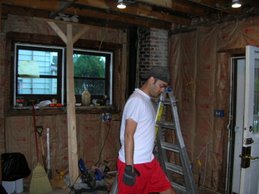Interest in environment:
-through design (materiality, technology....)
-interest is a result from reading and viewing pics of traditional and modern japanese architecture/architects
-focus for japanese architects is interaction and relationship with the natural environment (exemplified by work of tadao ando).
-man and natural world is continuous, and design and construction are one (ando)
-ando's philosophy: reconnect man to man - man to nature and architecture serves as the intermediary (seen with his use of light, shadow, materiality, and "placement" of buildings within nature).
What can I do?
-research different ways of learning about environment (seminars, classes, leed....)
-focus on self improvement through education, then work on community
(need to have an knowledge and understanding before any true contributions can be made)
Examples of leaders in the Community:
-Blaine Brownell, NBBJ Seattle
+currently a Fulbright scholar studying in Japan
+looking at sustainable materials
+published book "Transmaterial" all about eco-friendly materials
+has a blog journal showcasing materials (link on sidebar of blog)
+educating whole world on his research (his community)
-diller scofdio +renfro
+new typology: agriculture + architecture = agritecture
-for me
+educating in smaller community, build a strong base, then expand outward, they in turn are able to help inform others
Types of Projects:
-housing
-multi-use projects
-retail
Inform Others:
-building relationships with clients
-education through me and others (once knowledge is obtained)
-continual mentorship process for me and others, keep learning
Comments:
rick:
-is this attitude present in your office
-if this is not present, would you look for employment at a firm that embodies these practices
-any local columbus firms active leaders
-develop library of research materials similar to brownell's blog, only keep in your office as you learn, others can also. this could develop relationships with others that are interested also
-as you gain responsibility in career, implement the green ideals that you learn about
-word of caution or self examination, be sure if this is something you are passionate about. green is popular and the latest "buzz" word. others may view you with skepticism if passion and belief is not obvious
tim:
-call blaine brownell, ask him how we can influence the community and environment, through school, projects or speaking events
-become example to be followed (lead by example)
-URS and NBBJ both have resources for help
carli:
-frank lloyd wright, cheesy, but he integrated land into his buildings better then anyone else
-ds+r is a good example, also dutch housing on water that can rise and fall with the tide - actually most dutch architects are fairly good examples of this:
+Boreno Sporenburg
+Pueblo Housing
Subscribe to:
Post Comments (Atom)

2 comments:
Let's look for the underlying principles in your statement.
We need to do a better job of reconnecting to each other and to nature.
We are all automatically teachers through every action we undertake.
People in every field can do more to communicate the underlying ideas behind their work, and not just produce the objects they're charged with creating.
Your work must come from a deep commitment instead of the pursuit of a fad or fashion.
Humor is an effective means of spreading meaningful ideas.
Start to build a list of these underlying "truths" that can act as the foundation for your work.
In a way, isnt a deep rooted concern for the environment connected to design and reconnecting man with nature? I would agree that there is more to this reconnection with man and nature then just "green" architecture for me, such as the cultural differences between japanese and american architecture. for instance there is a sense of tradition and pride in craftsmanship involved with japanese architecture that doesnt seem as evident in most us architecture.
Post a Comment